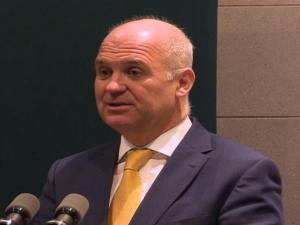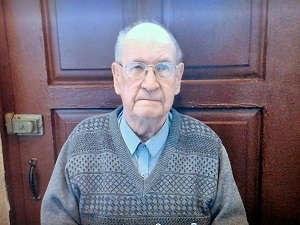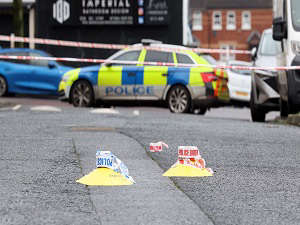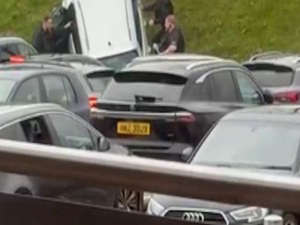
By David Young, Cate McCurry and Aine McMahon, PA
New evidence indicates people in Ireland are starting to increase movement and disregard social distancing rules, the chief medical officer has warned.
Dr Tony Holohan said two data sets - one from the Irish National Seismic Network measuring ground vibrations and the other from Apple Mobility Data on the use of iPhone mapping applications - show an upturn in movement both on the roads and on foot this week.
The information was outlined by the National Public Health Emergency Team (NPHET) hours after Taoiseach Leo Varadkar warned that complacency was the "new enemy" in the fight to contain Covid-19.
Mr Varadkar told the Dail that the virus could spread out of control if people became lax around social distancing.
Dr Holohan said the data provided an evidential base to back up concerns arising from anecdotal reports of a slackening in adherence to lockdown measures.
"You've got two completely different sources of information both suggesting or telling us the same thing - it gives us good hard evidence that in recent days we've seen some further movement in the population that we're advising against," the chief medical officer told the daily NPHET briefing.
He added: "It will take very little indeed for us to lose the good work that we've done. There's no sense in which we have achieved something here that couldn't all be undone very quickly."
The evidence appears to run contrary to data offered up by the Department of the Taoiseach earlier on Thursday.
It said figures from Transport Infrastructure Ireland (TII) on traffic volumes on the roads indicated that numbers this week were "in line" with other weeks during the restrictions.
The number of confirmed coronavirus cases in Ireland rose to 794 on Thursday, with 28 further deaths notified in the previous 24 hours.
There were 936 new cases of the disease confirmed, bringing the total since the outbreak began to 17,607.
Dr Holohan's warning on increased movement came as it was confirmed that the rate at which Covid-19 is spreading in Ireland has dropped again.
The reproductive number, which measures how many people an infected person infects, now stands at between 0.5 and 0.8.
Professor Philip Nolan, who leads a team modelling Covid-19 trends in Ireland, said the figure was evidence of the "extraordinary level of restraint" shown by people when it came to social distancing.
He said the reduction in the R0 number, along with figures showing hospital and ICU admissions were continuing to fall, demonstrated the disease was being effectively suppressed.
But he said more work was needed.
"It will take some time to drive it down to an acceptable level," he said.
Dr Nolan added: "It's under control but it's still at too high a prevalence in the population and in our nursing homes and in our hospitals for it to be safe to make any move at this point."
The current restrictions on movement in Ireland are due to expire on May 5.
Dr Holohan has repeatedly made clear that people should not automatically assume that measures will be eased on that date.
He said more progress was needed, particularly in efforts to contain outbreaks in nursing home settings, before the NPHET could recommend to the Government that some relaxation could take place.
"If today was the 5th of May we would not be advising, notwithstanding the very good progress that has been made, that we are yet at a point where we're ready to lift restrictions," said Dr Holohan.
He also responded to concerns raised by a number of opposition TDs on Thursday, including Fianna Fail leader Micheal Martin and Labour leader Alan Kelly, that there was not sufficient transparency around aspects of the state's coronavirus response.
Dr Holohan insisted the NPHET attempted to be as "open and transparent" as possible in all its work.
In another development on Thursday, Education Minister Joe McHugh confirmed that the revised date for the start of June's postponed Leaving Cert exams is now July 29.
The full timetable is due to be published in the first week of June, Mr McHugh told the Dail.
Meanwhile, the chief medical officer has also echoed comments from Health Minister Simon Harris that it is unlikely there will be regional differences in how restrictions are lifted in Ireland.
On Wednesday, Northern Ireland First Minister Arlene Foster said the region could emerge from restrictions at a different pace than other parts of the UK.
Mr Harris told the Dail: "That is something that is always under consideration but due to the size of the country, that has not been practical in terms of the transmission of the virus. That is always kept under review."
The minister said despite progress in flattening the curve of the disease, Ireland was "by no means in a safe place" and he urged the public to stick with the restrictions.
Earlier on Thursday, a professor of immunology raised concerns that Ireland's scale of testing for Covid-19 is picking up only one in 10 cases.
Paul Moynagh said officials need to ramp up the level of testing before considering lifting any of the current restrictions.
He told RTE's Morning Ireland: "I think we really need to look at testing in a very serious way, and begin to come up with a strategy, a road map and action plan in terms of where we're going with testing.
"If we're only picking up one in 10 cases, if we're going to use testing as an active way to suppress transmission, then we definitely need that in order to lift restrictions.
"The best defence we have against limiting transmission of this virus is isolation, and as we move inevitably to lifting some of the restrictions, we need something there to help us in terms of suppressing that transmission."


 Education Authority boss hits out at criticisms of public services
Education Authority boss hits out at criticisms of public services
 Man in 90s dies following Co Down road crash
Man in 90s dies following Co Down road crash
 Police to increase patrols after second incident of shots being fired in Belfast
Police to increase patrols after second incident of shots being fired in Belfast
 Woman charged over theft of campaigner’s car ‘must stay out of Belfast’
Woman charged over theft of campaigner’s car ‘must stay out of Belfast’
 Bluetongue restrictions in Northern Ireland will be relaxed from Friday
Bluetongue restrictions in Northern Ireland will be relaxed from Friday